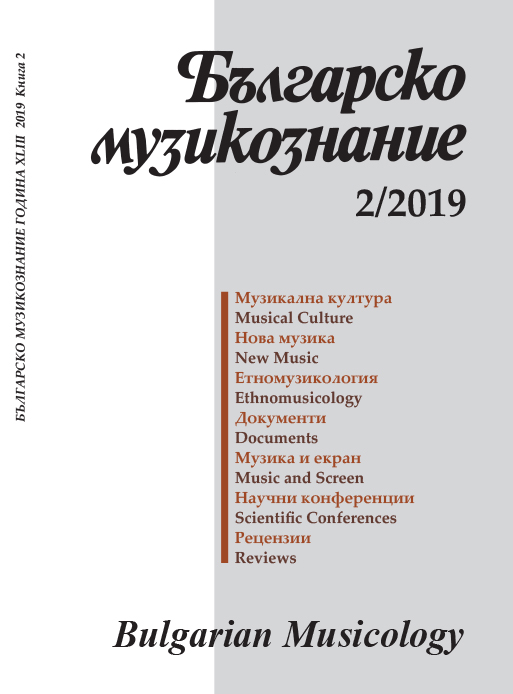Арнолд Шьонберг и неговата школа: постижения, наследство, влияние
Arnold Schönberg and his school: achievements, legacy, influences
Author(s): Stefan HarkovSubject(s): Fine Arts / Performing Arts, Music, Conference Report, History of Art
Published by: Институт за изследване на изкуствата, Българска академия на науките
Summary/Abstract: A conference on Austauschprozesse zwischen West und Ost in der europäischen Musikkultur unter dem Aspekt der Lehre von Arnold Schönberg und der Wiener Schule, held on 5 June 2019 at Arnold Schönberg Center, Vienna, was the second international meeting under a project for exchange between the East and West in European musical culture, organised under the auspices of the Department of Culture of Austria’s capital Third District, Landstraße. A Bulgarian, who lives in Vienna, Dr. Albena Naydenova, a chamber singer and musicologist, led the event. This year the focus was on the reception of Arnold Schönberg and his disciples’ oeuvre as well as their views on art. Researchers from Austria, Bulgaria, Lithuania, Romania, Russia and Ukraine took part in the event. The key speaker, prof. Hartmut Krones from Vienna, shed light on less known facts about Arnold Schönberg’s life, e.g. in the interwar period he was a citizen of the then newly established Czechoslovakia. In his paper the professor argued for a new interpretation of the term ‘Wiener Schule”. New publications were presented, such as the collection Die Rezeption der Wiener Schule in Osteuropa , containing works by eighteen European researchers among which Bulgarian professor Julian Kujumdzhiev. The reference point of Dr. Albena Naydenova’s paper was a sentence by Schönberg: ‘Dieses Werk ist der Schlüssel zu meiner ganzen Entwicklung’ (This work is the key to my entire development) . The work referred to was Gurre-Lieder composed in the period 1900 – 1911 at a time when his work saw a radical stylisticchange going from the aesthetics of the Late Romanticism to quests for new artistic devices. The paper offered an analysis of two less known documents about the performance of his work in 1920. The remaining eight papers dealt with the development of serial ideas and dodecaphony at the turn of the twenty-first century. Margarita Katunyan (Moscow) delivered a paper on early serial ideas in the music of the Russian composers Scriabin, Stravinsky, Roslavets, and Golyshev. Elena Zinkevуch (Kiev) spoke about the role of the Viennese School in the formation of Ukrainian composer Valentin Silvestrov in the 1960s, who was a member of the Kievan Avant-garde group of composers. Grazina Daunoraviciene (Vilnius, Lithuania) made a comparative analysis of Schönberg’s twelve-tone system and the dodekatonika of Osvaldas Balakauskas. Ana Szilágyi (Bucharest) talked about Schönberg’s influence on modality in the work of Romanian composers of the late twentieth century. Bulgarian musicology was represented in three research papers: Prof. Angelina Petrova (National Academy of Music, Institute of Art Studies, BAS, Sofia) gave an overview of the situation concerning music making in Bulgaria in the 1950s and 1960s, more specifically the use of the dodecaphonic technique. Prof. Julian Kujumdzhiev (Academy of Music, Dance and Fine Arts, Plovdiv) presented composer Ivan Spasov’s theoretical views on the dodecaphonic technique and its aesthetics. Prof. Stefan Harkov (University of Schumen) demonstrated how Schönberg and his school’s ideas influenced the writing of Le Miroir, Sept répliques pour un opéra possible by André Boucourechliev (1925 – 1997), a French composer of Bulgarian origin. The closing paper delivered by composer Dieter Kaufmann (Vienna) artistically, though at the same time reasonably, argued that Schönberg’s twelvenote composition is still as topical as it was in the days of its invention almost a century ago. The concert given after the conference featured pieces by contemporary Viennese composers (Erich Urbanner, Dieter Kaufmann, Herbert Lauermann, Wolfgang Hölzl) and a late Arnold Schönberg’s work, Fantasie für Violine und Klavier op. 47 (1949), performed by violinist Iva Nikolova, a Bulgarian performer based in Austria enjoying an international career. The conference sidebar, so to speak, included two major art events in Vienna related to Bulgarian musicians. Since early 2019, an exhibition has been on display at Haus Hofmannsthal dedicated to the ninetieth anniversary of Bulgaria’s great opera singer Nicolai Ghiaurov (1929 – 2004), a citizen of Austria since 1985 and bearer of Kammersänger and Ehrenmitglieder der Wiener Staatsoper. A curious fact was recalled: Ghiaurov and Schönberg were born on the same day, 13 September. Ensemble Wiener Collage, a chamber ensemble for contemporary music, gave a concert featuring pieces by composer Vladimir Panchev (b. 1948) on the occasion of his seventieth anniversary.
Journal: Българско музикознание
- Issue Year: 2019
- Issue No: 2
- Page Range: 115-119
- Page Count: 5
- Language: English, Bulgarian

